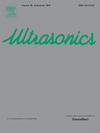A stochastic approach for calculating elastic constants of polymer lattice structures based on spectral ultrasonic data
IF 4.1
2区 物理与天体物理
Q1 ACOUSTICS
引用次数: 0
Abstract
Additively manufactured polymer lattices are increasingly used in biomedical and structural applications due to their tunable mechanical properties and architectural similarity to biological materials. However, accurately resolving their anisotropic elastic response remains challenging due to fabrication inconsistencies, energy loss mechanisms, and differences between static and dynamic characterization techniques. In this study, a dynamic technique, resonant ultrasound spectroscopy (RUS) was applied to a stereolithography-fabricated body-centered tetragonal (BC-Tetra) lattice composed of a polyurethane-like resin. Elastic constants were extracted from both experimental and model (FEA) eigenfrequencies using a particle swarm optimization (PSO) scheme with modified parameter tuning to improve exploration of the non-convex inversion space. Comparison of inverted elastic tensors showed strong agreement for the axial stiffness, and shear-related coefficients and , , while in-plane stiffness constants and and the axial coupling term exhibited the greatest variance, reflecting inversion sensitivity and the limited number of resonances below the continuum cutoff. Engineering moduli derived from RUS were internally consistent and in-plane values agreed closely with FEA predictions, but quasi-static measurements of the in-plane moduli and out-of-plane modulus were 20 % and 32 % lower, respectively. This divergence highlights fundamental differences in compliance across loading regimes: quasi-static compression is strongly influenced by strut bending, resin pooling, and boundary effects, whereas RUS probes free–free global vibrational modes that enforce affine deformation at the scale of the entire lattice, suppressing local compliance mechanisms and yielding higher effective moduli. Our study is an effort to test the boundaries of RUS for high-loss polymer lattices and to develop practices that could eventually reduce operator dependence.
基于超声光谱数据计算聚合物晶格结构弹性常数的随机方法。
增材制造的聚合物晶格由于其可调节的机械性能和与生物材料的结构相似性,越来越多地用于生物医学和结构应用。然而,由于制造的不一致性、能量损失机制以及静态和动态表征技术之间的差异,准确地解决它们的各向异性弹性响应仍然具有挑战性。在这项研究中,共振超声光谱(RUS)的动态技术应用于立体光刻制造的体心四边形(BC-Tetra)晶格组成的聚氨酯类树脂。采用粒子群优化(PSO)方法从实验和模型(FEA)特征频率中提取弹性常数,改进了参数调整,提高了对非凸反演空间的探索能力。反向弹性张量对比显示,轴向刚度、C33和剪切相关系数C44和C66具有较强的一致性,而面内刚度常数C11和C12与轴向耦合项C13的差异最大,反映了反演敏感性和在连续统截止点以下的有限共振次数。从RUS得到的工程模量在内部是一致的,面内模量与有限元预测非常吻合,但面内模量E1=E2和面外模量E3的准静态测量值分别降低了20%和32%。这种差异突出了不同加载模式下柔度的根本差异:准静态压缩受到支撑弯曲、树脂池化和边界效应的强烈影响,而RUS探测的是在整个晶格尺度上强制仿射变形的自由-自由全局振动模式,抑制了局部柔度机制,产生了更高的有效模量。我们的研究是为了测试高损耗聚合物晶格的RUS边界,并开发最终可以减少操作员依赖的实践。
本文章由计算机程序翻译,如有差异,请以英文原文为准。
求助全文
约1分钟内获得全文
求助全文
来源期刊

Ultrasonics
医学-核医学
CiteScore
7.60
自引率
19.00%
发文量
186
审稿时长
3.9 months
期刊介绍:
Ultrasonics is the only internationally established journal which covers the entire field of ultrasound research and technology and all its many applications. Ultrasonics contains a variety of sections to keep readers fully informed and up-to-date on the whole spectrum of research and development throughout the world. Ultrasonics publishes papers of exceptional quality and of relevance to both academia and industry. Manuscripts in which ultrasonics is a central issue and not simply an incidental tool or minor issue, are welcomed.
As well as top quality original research papers and review articles by world renowned experts, Ultrasonics also regularly features short communications, a calendar of forthcoming events and special issues dedicated to topical subjects.
 求助内容:
求助内容: 应助结果提醒方式:
应助结果提醒方式:


